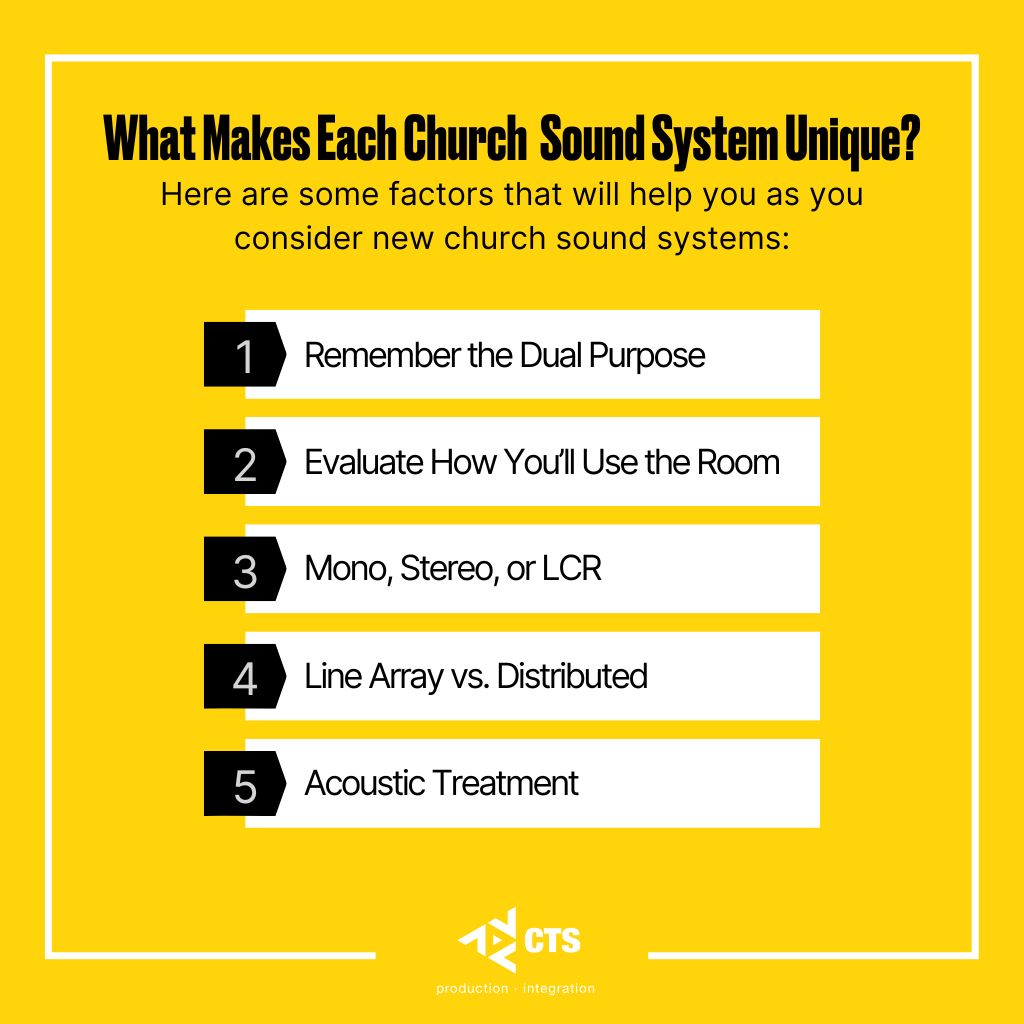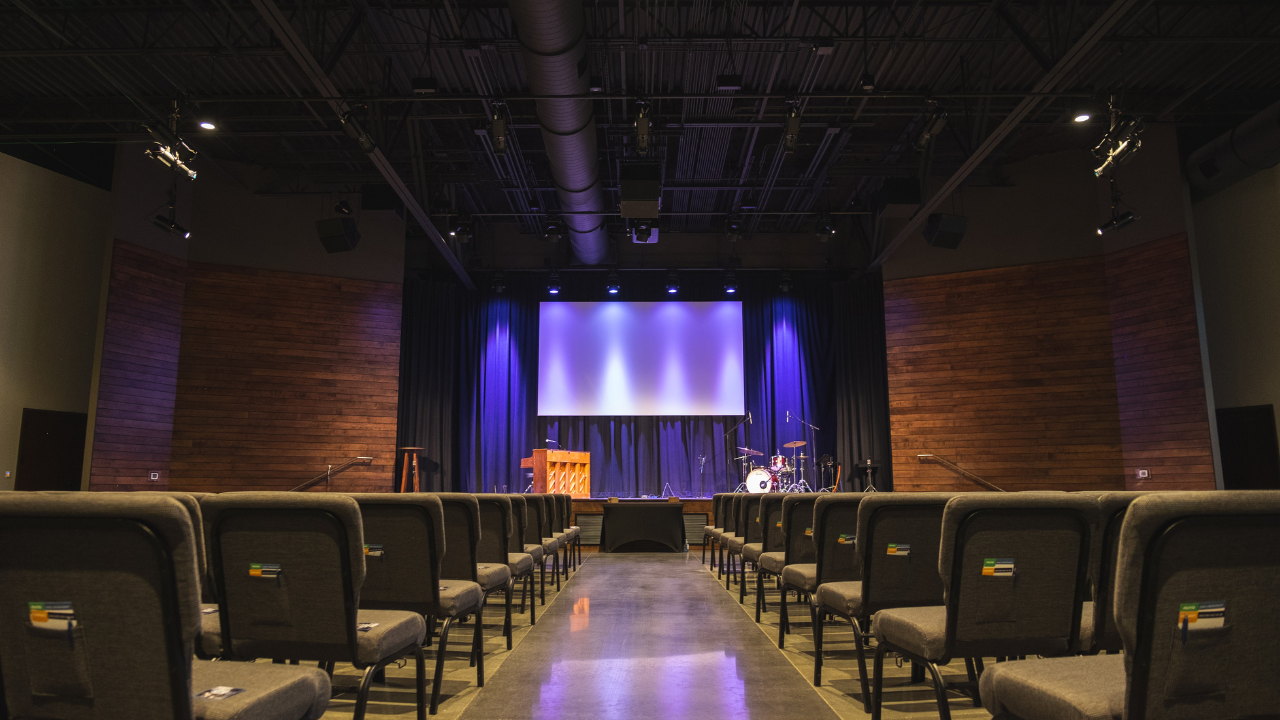5 Things To Consider Before Buying Your Church Sound System
Published on: Tuesday, September 20, 2022 - 7:00am

If you’re in the market for a new oven, you might ask around and see what your friends and family are using. What brand do they have? What features are their favorites? How much did it cost?
It’s perfectly reasonable to get friendly advice about an oven, but choosing a new church sound system isn’t quite as straightforward. Audio design involves too many nuances to cut and paste another church, venue, or arena’s setup and get the same outcome. There are just too many moving parts.
What Makes Each Church Sound System Unique?
On the surface, a lot of sanctuaries and worship centers seem similar. But it’s the small differences you don’t immediately notice that demand unique, tailored church sound systems.
Every room is architecturally different — a slightly distinct shape, size, height, or wall position. The various uses for the room, the sound quality, and the budget are all different for every church.
All those little nuances feed into audio design. What worked in someone else’s rectangular room won’t work in your fan-shaped room — and there’s a good chance it may not even be ideal for your rectangular room. Whether you’re dealing with new construction or renovation, it takes careful attention to these nuances to achieve audio design that works in each unique space.
So if replicating someone else’s setup won’t work, what factors will help you as you consider new church sound systems?
1. Remember the Dual Purpose
For churches, the spoken word is of the utmost importance. It needs to be heard and intelligible — throughout the entire room. However, worship is also an incredibly important part of church services, and sound systems need to deliver not only a clear spoken message but also an engaging musical experience.
Many different types of church sound systems can achieve very high-quality spoken word intelligibility AND warm musical sound as long as they’re designed properly, taking care to ensure they work hand in hand with the architecture and the acoustical performance. With precision design for the space, they provide an optimized environment for both music and spoken word that eliminates the need to prioritize one over the other.
2. Evaluate How You’ll Use the Room
The next step is to identify all the ways you’ll be using the space where you’re installing your sound system. Will you host community events, conferences, or concerts? Is the room a multipurpose space, hosting primary services on Sundays and youth events during the week? Or is it strictly a worship center?
The sound system will need to be capable of handling all the major uses of the room. And depending on how you answer the above questions, you may also need to consider the simplicity of operating the system. If the space will host a lot of community events with technicians of varying levels of expertise, you’ll want your audio system built with a level of operational simplicity that doesn’t require multiple full-time experienced staff members to be on hand for every event.
Or, if outside concerts will be a significant element, you might opt for higher quality and more capable equipment that can support concerts without a constant need for additional rentals.
3. Mono, Stereo, or LCR
As far as the configuration and how people experience it, the traditional options are mono, stereo, and LCR (left, center, right) sound systems. There are immersive systems as well, but we’ll get into that another time.
Stereo and LCR systems are slightly more complex to operate than mono systems. It’s beneficial for operators to have a better idea of how to build a mix, while being aware of imaging and localization. That’s something to consider if ease of use is an important factor for your church. Stereo and LCR systems will also be more expensive than mono systems because of the additional speakers, amp channels, and wire pull.
LCR can work great in especially wide rooms, but depending on the use of the space and content, it may offer few benefits. Audio technicians and engineers will almost always prefer a stereo audio system over a mono system because it provides greater flexibility and creativity in the mix. Despite this, stereo isn’t the best choice for every room, either.
Not every space can effectively support a stereo sound experience, whether because of the room’s seating layout, architecture, or other factors. If 75% of the people in the room can’t hear sound from both sides, then is purchasing a more expensive stereo system worthwhile? It’s possible, but that’s an important conversation to have..
4. Line Array vs. Distributed
Line array, compared to distributed conventional systems, is still the “new” approach to church sound systems, even though it’s been around for many years. It offers a lot of benefits, and in many cases is the appropriate choice for a system design.
However, line array is not a requirement, and it’s not necessary in every space. In some cases, it’s actually less efficient and effective than a properly designed distributed conventional speaker system.
One of the benefits of line array is that it can project clear audio much farther than a conventional speaker cabinet, making it very effective in longer, deeper rooms. But if you’re in a short room, though line array could still provide some benefits, you don’t need that level of throw. Since it will almost always be more expensive and you don’t need one of its greatest assets, you might consider going with a less expensive distributed system instead.
Both line array and distributed sound systems can perform well in large and small venues. There’s a way to use both design concepts to create functional systems. It’s really about what is the most efficient use, which can bring the most gains, and what is appropriate for your building.
5. Acoustic Treatment
You can’t separate your acoustic treatment from your church sound system. They work hand in hand, and both need to be efficient and work well together. You can’t have good acoustics and a bad PA, or vice versa, and expect to be happy with the results. It’s important that both are designed comprehensively and in tandem with each other.

Get Insight From Experts
While checking out your neighboring church’s sound system will help to offer context, as we’ve discussed here, it won’t tell you which approach is right for you. So what now? How will you know what your room is best set up for? How will you know if you need a mono, stereo, or LCR system, or line array versus distributed conventional?
The best step you can take in planning for a new sound system for your church is to consult with a trusted AVL expert who can help you evaluate your options and guide you through the decision-making process.



